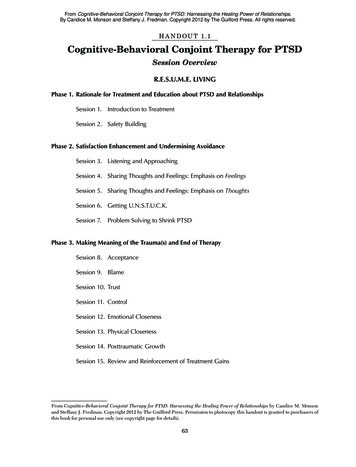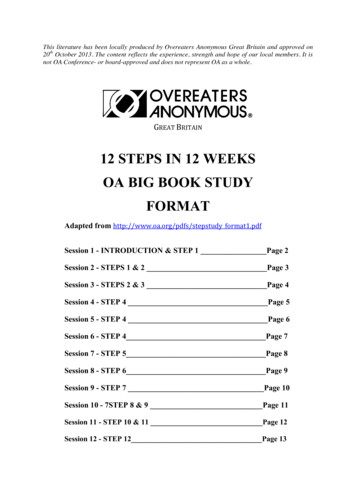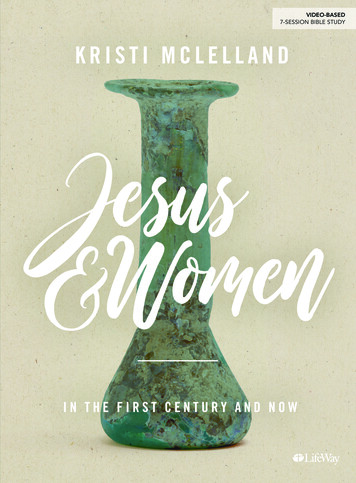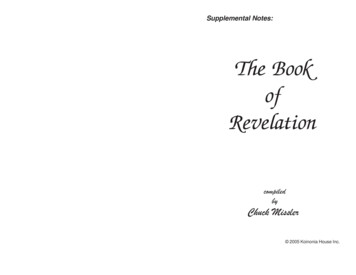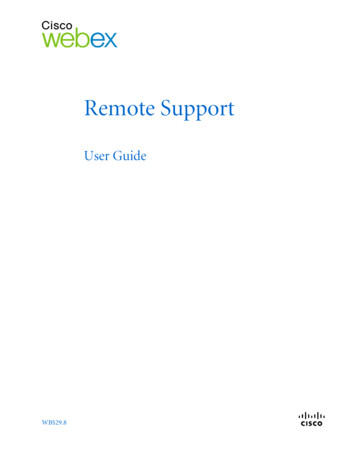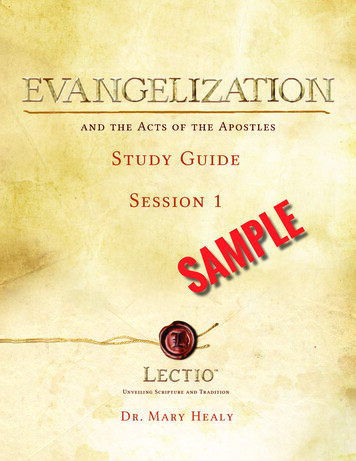
Transcription
Study GuideSession 1MAELPSDr . Ma r y Hea l y
Nihil Obstat: Dr. André Villeneuve, Censor LibrorumImprimatur: Most Reverend Samuel J. Aquila, S.T.L., Archbishop of DenverMarch 2016Copyright 2016 Augustine Institute. All rights reserved.With the exception of short excerpts used in articles and critical reviews, no part of this workmay be reproduced, transmitted, or stored in any form whatsoever, printed or electronic,without the prior permission of the publisher.Some Scripture verses contained herein are from the Catholic Edition of the RevisedStandard Version of the Bible, copyright 1965, 1966 by the Division of Christian Educatorsof the National Council of the Churches of Christ in the United States of America. Used bypermission. All rights reserved.English translation of the Catechism of the Catholic Church for the United States of America,copyright 1994, United States Catholic Conference, Inc.—Libreria Editrice Vaticana. Englishtranslation of the Catechism of the Catholic Church: Modifications from the Editio Typicacopyright 1997, United States Catholic Conference, Inc.—Libreria Editrice Vaticana.Writers: Heather Akers, Ashley Crane, Kris Gray, Therese ObagiVideo Production: Jon Ervin, Steve Flanigan, Justin Leddick, Kevin Mallory, Ted Mast,John SchmidtPrint Production/Graphic Design: Ann Diaz, Brenda Kraft, Jane Myers, Devin SchadtAugustine Institute6160 South Syracuse Way, Suite 310Greenwood Village, CO 80111For more information: 303-937-4420Formed.orgPrinted in the United States of AmericaISBN 978-0-9972037-2-1(Cover Art) Christ appearing to his disciples at the mount of Galilee / Scala / Art Resource, NY
TableofContentsEVANGELIZATIONand the Acts of the ApostlesWelcome to Lectio1Session 1: Why Study Acts?3Session 2: Clothed with Power23Session 3: Proclaiming the Kerygma43Session 4: Signs and Wonders61Session 5: How Jesus Makes an Evangelist79Session 6: Sacraments and the Spirit97Session 7: Leadership in the Church117Session 8: Charisms of the Spirit137Session 9: Joy in Persecution157Session 10: The Belly of the Beast175Leader’s Resource Guide starts on page195III
What Is LECTIO?To read is to discover meaning from written symbols or text.Letters form into words, words into sentences, and sentences intowhole paragraphs and pages that communicate our thoughts,teach new ideas, and narrate stories that we find amusing,sorrowful, imaginative, or deeply profound.The Latin term lectio means “reading.” The tradition of readingSacred Scripture for prayer and reflection was practiced by many ofthe early Church Fathers—St. Ambrose, St. Jerome, St. Augustine,St. Cyprian, and St. John Chrysostom, just to name a few.Benedictine monks later developed this practice into the traditionknown as lectio divina, or “divine reading.”Lectio uses the practice of prayerful reading and study to helpus dive more deeply into the truths of the faith and discoverthe profound meaning and purpose of Sacred Scripture, SacredTradition, and Church History. We combine engaging sessions ledby Catholic teachers with practical guidance for living the faith anddeveloping the disciplines of reading, reflecting, and responding.By prayerfully reading and understanding the texts of SacredScripture and Tradition, we can come to discover the story ofsalvation into which our Baptism has united us, the historyof God’s people through the centuries, and the depth of God’slove for each of us.IV
W ELCOME TO LECTIOWelcome to the Lectio Study Series. In these sessions of LECTIO, you will discover theprofound importance, meaning, purpose, and beauty of Sacred Scripture and Sacred Tradition,as seen through the eyes of the Church.LECTIO studies are designed for Adult Faith Formation to help unveil both Sacred Scriptureand Sacred Tradition. The Latin word lectio means “reading,” and often refers to a careful andprayerful reading of Scripture. These studies cover a wide variety of topics, including individualbooks or letters of the Bible, the lives and writings of the saints, Church teaching, and topics tohelp serve the formation of Catholics living out the call of the New Evangelization.A LECTIO SESSIONThis Study Guide takes you step by step through each session, both the small group gatheringand video teaching, as well as five days of personal follow-up study. The resources are carefullycrafted to lead you through an opening of your heart and mind to God’s Word and the traditionsof the Catholic Church.Here is what you will find in each Lectio session:C O N N ECT1. O pening Prayer: For this study on Evangelization, we have chosen the Prayer to theHoly Spirit.2. Introduction: We begin with a brief overview of the topic, including the key points for thesession. This helps contextualize the topic, show its relevance for daily life, and inspire youto delve into a particular aspect of the faith.3. C ONNECT Questions: After reviewing the verse and daily reflections from the previoussession, you’ll share your thoughts on questions related to the new session.V I DEO4. Video Teaching: The video segments present teaching that delves into and makes relevantthe Sacred Scripture and Sacred Tradition of the Catholic Church. The video teachings for thestudy on Evangelization and the Acts of the Apostles are presented by Dr. Mary Healy, AssociateProfessor of Sacred Scripture at Sacred Heart Major Seminary in Detroit. An outline of eachteaching is included in the Study Guide.D I S CUS S5. D ISCUSS Questions: Each video segment is followed by questions that will help youpersonalize and take ownership of the topics of the session.6. Memory Verse: The Psalms encourage us to treasure God’s Word in our heart throughmemorization, saying, “I have laid up thy word in my heart ” (Psalm 119:11). You are encouragedto memorize and reflect on a Scripture verse for every session to help nurture your faith. losing Prayer: The Closing Prayer has been chosen to reflect back to God an appropriate7. Cresponse to his loving action in the session.8. For Further Reading: For supplemental study, you are encouraged to refer to the additionalreading resources.1
9. Qu otes, Tips, and Definitions: We have included throughout the study interesting quotesand excerpts from saints, Catholic documents, the Catechism of the Catholic Church, andCatholic authors to enhance your understanding of each topic.COMMI TThe Study Guide includes five daily COMMIT reflections that will help you more deeply explorethe main topics of each session and more firmly commit to following Christ in your daily life.These reflections include more information on Sacred Tradition and Sacred Scripture, as wellas topics such as geography, history, and art. Some of these reflections will also include times ofprayer, including the practice of Scripture meditation known as lectio divina.A n O ver view of L e c t i o D i v i n aLectio divina is an ancient practice of enhancing one’s prayer life through the power of God’sWord. The term itself means “divine reading” of the Sacred Scriptures. It is our hope that by usingthese simple steps each day as you study Sacred Scripture in LECTIO, you will develop an effectiveway to study and pray with God’s Word and hear God’s voice in your daily life. Sacred Reading of the Scriptures (lectio): The reading and rereading of the Scripturepassage, paying close attention to words, details, themes, and patterns that speak to you. Meditation (meditatio): Meditating or reflecting on what you’ve read to gainunderstanding. Allow the Holy Spirit to guide you as you spend time pondering whatyou have read and striving to understand it in meditation. Prayer (oratio): A time to bring your meditative thoughts to God in prayer. Talking withGod about how the connections and implications of your meditation on the Scriptureaffect your life and the lives of those around you. Contemplation (contemplatio): A time of quiet and rest, we listen and await God’s voice.Contemplation allows one to enter decisively and more deeply into the mystery of God—this is no small endeavor, so be patient as you engage this step and strive to be receptiveto God’s voice speaking into your life. Resolution (resolutio): A call for resolution and action, inviting you to respond to thethings you have read in Scripture and have prayed about, and to put them into practice.To learn more about lectio divina, refer to Dr. Tim Gray’s book Praying Scripture for a Change,available at www.AscensionPress.com.2
O P E N I N G P R AY E RCome Holy Spirit,fill the hearts of your faithfuland enkindle in themthe fire of your love.Send forth your Spiritand they shall be created.And you shall renew the face of the earth.Let us pray.O, God, who did instructthe hearts of the faithfulby the light of the Holy Spirit,grant that by the same Holy Spiritwe may be truly wiseand ever rejoice in his consolation.Through Christ our Lord,Amen.INTRODUCTIONThe Church has been spreading the gospelfor nearly 2,000 years, but people in ourmodern world seem to have closed their earsand hearts to the good news of Jesus Christ.The “signs of the times” show us a world thatis in desperate need of the gospel, and yeta “New Evangelization” appears at times toface insurmountable difficulties. How do wego about effectively evangelizing the modernculture in which we find ourselves? Canstepping back and looking at how the firstChristians turned the ancient world upsidedown give us a key for transforming ourmodern world? Let’s take a look.Christ appearing to his disciples at the mount ofGalilee / Scala / Art Resource, NY3
C o n n e ctWhat do you think of when you hear the word “evangelize”?Do you think that spreading the faith is a priority for the Catholic Church? What about for yourparish, specifically?DiscussPA R T 1 : S i g n s o f t h e T i m e sWatch the video teaching. The following is a brief outline of the topics covered.I. Reading the Signs of the TimesA. Gaudium et Spes (The Church in the ModernWorld) (Vatican II) calls us to do just thisB. A “tsunami of secular influence”1. Many baptized Christians are no longerliving the Christian life2. Many are living a “practical atheism,”living as if God did not exist 3. Many hold ideas of God that are aliento Christian faith4. This secularism began with Enlightenment,when an outward framework of Christiansociety remained5. But today, no longer a basic consensusin agreement with the gospel6. Today, a new militant atheism andattempts to banish God4
Why Study Acts?II. We Live in a Time of Biblical IlliteracyA. Biblical worldview helps us make senseof historyB. Biblical worldview helps us make senseof our own livesIII. The World Is a Spiritual War ZoneA. Pope Francis: “The Church is a field hospital” B. If a field hospital, then bullets whizzing byC. Time has passed for business as usualD. Each of us is born for such a time as thisDiscuss1. What was one thing you heard for the first time or that was an “aha” moment for you?2. In what ways have you experienced or witnessed the “tsunami of secularism” mentioned byCardinal Wuerl? How might this make evangelization difficult?3. What is the difference between living according to a “practical atheism” and livingaccording to a biblical worldview? What can we do to foster a biblical worldview inourselves and in others?PA R T 2 : A B l u e p r i n t f o r t h e C h u r c hWatch the video teaching. The following is a brief outline of the topics covered.I. Evangelization Is the Mission of the ChurchA. Pope Bl. Paul VI: “[The Church] existsin order to evangelize”B. Pope St. John Paul II: Time to committo a New Evangelization1. No longer just to those in remote locations2. Re-evangelization of Western culture 5
Why Study Acts?C. P ope Francis: Each Christian is to be amissionary discipleII. How Have We Been Responding So Far?A. O nly 30% of baptized American Catholicspracticing their faithB. Fastest growing category is “nones”—those who identify as having no religionC. O f those who are newly baptized into theChurch, within a year, half or more stopattending Mass regularlyD. Only 6% of Catholics feel that spreadingthe faith is a high priorityE. C atholics scored lower than even atheistsin knowledge of the Bible and ChristianityIII. Something More Needs to HappenA. Need to look at the First EvangelizationB. Acts of the Apostles as a blueprint Discuss4. We are tasked with evangelizing a society that was once largely Christian, but hasabandoned the gospel. How is the need for evangelization today both similar to and differentfrom the situation of the first Christians? What particular challenges do you think exist inevangelizing a post-Christian culture?5. Pope Francis has called for each Christian to be a “missionary disciple.” What does thismean? What can you do to live out this call?PA R T 3 : A c t s o f t h e A p o s t l e sWatch the video teaching. The following is a brief outline of the topics covered.I. St. LukeA. Author of the Gospel of Luke andActs of the ApostlesB. Only Gentile author of the New TestamentC. A cts 16:10: “We” appears; first-person narrativeshowing St. Luke was an eye-witness6
Why Study Acts?D. Excellent historian, but not a modern historianE. Shapes what he writes theologicallyII. Th e Opening of the Acts of the ApostlesA. Gospel only tells what Jesus“began to do and teach”B. Jesus continues to act and teachthrough his ChurchC. Repeats Great Commission and the promiseof the Spirit from end of gospelD. Evangelization is first God’s workIII. Mary, Model for the ChurchA. Annunciation is a proto-PentecostB. Visitation is the first Christian evangelization1. Mary can’t keep Jesus to herself2. The Spirit is contagious—John leaps andElizabeth is filled with the Spirit 3. Overflowing praise IV. W e Need a New PentecostDiscuss6. What does the opening of the Acts of the Apostles teach us about evangelization? How canwe apply this to our evangelization efforts today?7. What are the similarities between the coming of the Holy Spirit in the Acts of the Apostles(Pentecost) and the coming of the Spirit in the gospel (the Annunciation)? How does Mary seta model of evangelization for us?7
Why Study Acts?“These men who have turned the world upside down.”—Acts 17:6C L O S I N G P R AY E RLord Jesus Christ,by the power of the Holy Spiritthe first Christiansturned the world upside downfor love of you.By that same Spiritmay we have the courageto live lives of missionary discipleshipin order to share the gospeland transform our worldfor the glory of your name.Amen.St. Luke, pray for us.FOR FURTHER READINGPope St. John Paul II, Redemptoris Missio (Mission of the Redeemer)Joseph Cardinal Ratzinger, Address to Catechists and Religion Teachers, Jubilee of Catechists(December 2000)Pope Bl. Paul VI, Evangelii Nuntiandi (Evangelization in the Modern World)“Those who with God’s help have welcomed Christ’s call and freely responded to it areurged on by love of Christ to proclaim the Good News everywhere in the world.”—CCC 38
C o m m i t –D AY 1ST. L UKEBefore studying any literary work, it is helpful to know something about the author. Anauthor’s background, credentials, and purpose impact our understanding of what he or she haswritten. The same is true in studying Scripture. Knowing the author of a particular book of theBible gives us insight into understanding the work and the way in which it is written.The Acts of the Apostles isattributed to St. Luke, along withthe gospel that bears his name.The book of Acts is clearly writtenas a sequel to Luke’s gospel, asthe author begins both works byaddressing a specific recipient,Theophilus (see Luke 1:1-3 andActs 1:1), and Acts is specificallydesignated to follow the “firstbook” (Acts 1:1). Luke’s gospelends with Jesus’ Resurrection andAscension; and Acts opens withthese same two events. In fact,Jesus’ words at the AscensionSt Luke the Evangelist writing his Gospel watched by his symbol, an ox / HIP / Art Resource, NYrecorded in Acts 1:8, “But you shallreceive power when the Holy Spirit has come upon you; and you shall be my witnesses inJerusalem and in all Judea and Samaria and to the end of the earth,” provide the structure forthe rest of the book. Acts 1–7 describes Jesus’ Ascension, the Apostles’ reception of the HolySpirit at Pentecost, and their immediate preaching in Jerusalem; chapters 8–12 describe thegospel spreading to Judea and Samaria; and in chapters 13–28 Christianity begins its spread tothe rest of the Roman world, whose empire stretched to the reaches of the known world.The story of Acts concludes with St. Paul being placed under house arrest in Rome.Interestingly, St. Luke doesn’t include major events of the following years in the Acts ofthe Apostles—events such as the Great Fire of Rome in 64 AD; Nero’s persecution of theChristians, including the martyrdoms of Sts. Peter and Paul, following thereafter; and theconquest of Jerusalem and destruction of the Temple in 70 AD. Perhaps Luke had alreadywritten Acts by that time; or perhaps Paul’s arrival at Rome, the capital city of the Romanempire, where Paul was “preaching the kingdom of God and teaching about the Lord JesusChrist quite openly” (Acts 28:31), provided the matching bookend to Jesus’ opening wordsin Acts 1:8, showing that the gospel had indeed spread to the ends of the earth. Regardlessof Luke’s reason for concluding as he does, his open ending of Acts moves us right into therest of the history of the Church that follows the Apostolic Age.9
Why Study Acts?St. Luke was a Gentile, and the only non-Jewishauthor of a New Testament book. Luke mixes the bestof Hebrew and Greek styles of history in his writing.Like the Hebrew authors of the Old Testament, Lukerecords the theological sense of history as he shows howGod is the author of all history and the power behindthe events narrated in Acts. Thus, for example, Lukerecords the angel of God setting free the Apostles (seeActs 5), and later St. Peter (see Acts 12), from jail. Likehis contemporary Greek writers, Luke also focuses onthe moral lessons contained in the history of the earlyyears of the Church. The very title of his second work,“Acts” takes its name from an ancient Greek literarygenre focused on studying the deeds and acts—praxisSaint Luke the Evangelist, about to write the Gospel / Alfredoin Greek—of great men so that these deeds were notDagli Orti / Art Resource, NYforgotten and that others might imitate them and, indoing so, build up human civilization. In writing his account as an “Acts” or praxis, Luke isinviting his Christian audience to imitate the virtuous lives of the Apostles, who in turn areimitating Christ himself, not simply to build up human civilization, but to build up the Kingdomof God.By occupation St. Luke was a physician (see Colossians 4:14). After his conversion, Lukeaccompanied St. Paul on some of his journeys. In Acts 16:10, Luke switches his narrativefrom the third person to the first person. His use of “we” and “us,” here and in otherpassages, indicates that Luke was an eyewitness to many of the events he records in theActs of the Apostles.Look up Acts 16:10–17; 20:5–21:18; and 27:1–28:16. What are some of the events St. Lukewitnessed or participated in? Why is Luke’s status as an eyewitness important to ourunderstanding of Acts?Piecing together Acts of the Apostles and the letters of St. Paul, we get a fuller picture ofSt. Luke’s ministry. Luke remained in Philippi when Paul departed (Acts 16:40), most likelyto continue preaching the gospel in that city. According to Philippians 4:15-16, the church atPhilippi sent Paul monetary aid while he was in Thessalonica, and Luke probably arrangedthis support. Paul met Luke again when he returned to Philippi. Paul wrote his second letterto the Corinthians during this visit to Philippi, and according to St. Jerome, the “brother”mentioned in 2 Corinthians 8:18 is Luke, and Luke was one of the messengers who tookPaul’s letter back to Corinth. Luke returned to Jerusalem with Paul and remained with himthrough Paul’s two-year imprisonment in Caesarea and his journey to Rome. Luke was10
Why Study Acts?present with Paul in Rome for at least part of his first imprisonment there, as he is mentionedin two of the three letters Paul wrote during that time (Colossians 4:14 and Philemon 1:24,but not in the letter to the Ephesians). Luke was also at Paul’s side for his last imprisonment,as Paul states in 2 Timothy 4:7-11. Not much is known about Luke’s life after the martyrdomof Paul. One ancient historian (Epiphanius) writes that he preached in Dalmatia, Gallia (orGalatia), Italy, and Macedonia. An ancient tradition says Luke died in Boeotia in Greece at 84years old, unmarried and “full of the Holy Spirit.”St. Luke / Smithsonian American Art Museum, Washington, DC / Art Resource, NYSt. Luke is the patron saint of doctors, being a physician himself. An ancient tradition holdsthat he painted several pictures (icons) of the Virgin Mary and child Jesus, including the SalusPopuli Romani preserved in the Basilica of St. Mary Major in Rome. Because of this Luke isconsidered the father of Christian iconography and is the patron saint of painters. Drawing fromthe traditional symbols of the four gospel writers (described in Revelation 4:6-7—man, lion, ox,eagle), Luke is often represented by the ox, since he opens his gospel with the priest Zechariah inthe Temple, and cattle were among the animals used for Temple sacrifice. St. Luke’s feast day iscelebrated on October 18.11
C o m m i t –D AY 2Signsof theTimes“The Church has always had the duty of scrutinizing the signs of the times and of interpretingthem in the light of the Gospel. Thus, in language intelligible to each generation, she can respondto the perennial questions which men ask about this present life and the life to come, and aboutthe relationship of the one to the other. We must therefore recognize and understand the worldin which we live, its explanations, its longings, and its often dramatic characteristics.”—Gaudium et Spes, 4The Second Vatican Council reaffirmed the Church’s duty to read the signs of the times, not inorder to conform to those times, as so many would have the Church do, but to better address thegospel message “in language intelligible to each generation.” In order to share the good news ofJesus Christ in a way that is relevant and inviting, we must know our audience—what are theysearching for? What are their needs and fears? In order to show each new generation how thegospel answers such questions, we must read the signs of the times.The signs of the our current times reveal a world that hasn’t simply turned away fromChristianity, but one that has also turned toward secularism, relativism, and hedonism. Inshutting God out of the picture, a vacuum opens up that must be filled with something. As thelyrics of one Bob Dylan song reminds:“But you’re gonna have to serve somebody, yes indeed.You’re gonna have to serve somebody.It may be the devil or it may be the Lord,But you’re gonna have to serve somebody.”In abandoning a biblical worldview, modern society has opened itself up to a wide varietyof alternatives. What are some of the secular worldviews you have encountered in yourinteractions with others? How have such interactions impacted your life?In many parts of the world today, Christians are experiencing intense persecution and evenmartyrdom—a fact that is often largely ignored by secular society. In the West this persecution ismore subtle. As secularism gains power, Christians are expected to practice their faith in privateand live their public lives according to rules of political correctness and “tolerance.” Letting one’sfaith inform one’s business decisions or political activity is often seen as forcing one’s faith onothers, rather than as a right to be protected. The signs of the times point to a world increasinglyhostile to the Church. Have you or someone you know experienced persecution for your faith?What happened? How did you respond?12
Why Study Acts?The signs of the times also point to some causes of concern within the Church as well. Lowparticipation in Mass and the sacraments, and a lack of understanding about even the Church’smost basic teachings, are all too common among men and women who identify as Catholic.As dark as these times seem, this isn’tthe first time in history that God’speople have faced difficulties arisingfrom a world in desperate need ofconversion. Consider the story ofJonah. In the mid-8th century BC, theNorthern Kingdom of Israel was facingthreats from the neighboring AssyrianEmpire. God called Jonah to travel deepinto enemy territory to the Assyriancity of Nineveh and call the people ofthe city to repentance. Jonah didn’twant anything to do with this missionto Israel’s enemies and took off in theopposite direction. After a storm at seafollowed by three days of darkness,distress and anguish in the belly of thegreat fish, God heard Jonah’s prayerand gave him a second chance. He wentto Nineveh and walked the city streets,warning the people that God woulddestroy their city if they didn’t repentof their sins and change their ways.Then he set up camp outside the cityJonah and the Whale, drawings by Gustave Dore Nicku / shutterstock.comto watch the impending destruction ofhis people’s wicked enemies. But Jonah was in for a surprise. The people of Nineveh heeded hismessage. They turned away from their wickedness, and God spared them, pouring out his mercyand bringing about a conversion of Israel’s enemy.Scripture also gives us examples of internal reform and conversion of God’s people during thereigns of two kings of the Southern Kingdom of Judah, Hezekiah (2 Chronicles 29:31) and Josiah(2 Chronicle 34). Both kings, Hezekiah starting in the late 8th century BC, and Josiah threegenerations later, were faithful men of God in the midst of a nation that had largely turned awayfrom God and forsaken his commandments. Both Hezekiah and Josiah worked to eradicateidolatry and renew the liturgical life of God’s people centered on the Temple in Jerusalem. Theyrepaired the Temple, renewed the nation’s dedication to God’s Law, and lived lives of faithfulnessand trust in God. Although both Hezekiah and Josiah ascended the throne of a kingdomwandering far from God, both kings enacted radical reforms and under their rule Judah was onceagain faithful and enjoyed God’s favor.13
Why Study Acts?How do the stories of Jonah, Hezekiah, and Josiah apply to our own times? What encouragementand lessons can we draw from these stories?The times in which we findourselves call for both our owndeeper conversion and fidelity toJesus Christ and his Church, aswell as a creativity to apply thetruth of the gospel to the questionsasked by the men and womenof the culture around us. As Dr.Healy shared in the video, theNew Evangelization is still aboutproclaiming the gospel to thosewho have never heard it, but evermore often it is proclaiming thegospel to those who think theyalready know it and have rejectedit. As Venerable Fulton Sheenfamously said, “There are not onehundred people in the UnitedStates who hate the CatholicChurch, but there are millionswho hate what they wronglyperceive the Catholic Church tobe.” For a New Evangelization tobe successful, we must allow theSpirit to fill us with a new vigorand zeal for sharing the goodJesus Preaches in the Synagogue, drawings by Gustave Dore. Nicku / shutterstock.comnews of Jesus Christ. We mustbe willing to explore new methods of sharing the gospel, and we must share it with a new andfresh expression so that our jaded, post-Christian world will open their ears and their hearts.14
C o m m i t –D AY 3L e ct i o : T h e V i s i tat i o nSt. Luke includes a beautiful symmetry between the beginning of his gospel and thebeginning of the Acts of the Apostles. Both books begin with a coming of the Holy Spiritfollowed by an act of evangelization—sharing the love of God communicated by the HolySpirit. Reading and praying through Mary’s visitation to her cousin Elizabeth allows us theopportunity to meditate on the first act of Christian evangelization and sheds light on ourown call to share the good news of Jesus Christ with others.L E C T I O : The practice of praying with Scripture, lectio divina, begins with an active andclose reading of the Scripture passage. Read the Scripture passage below and then answerthe questions to take a closer look at some of the details of the passage.“In those days Mary arose and went with haste into the hill country, to a city of Judah,and she entered the house of Zechariah and greeted Elizabeth. And when Elizabeth heardthe greeting of Mary, the child leaped in her womb; and Elizabeth was filled with the HolySpirit and she exclaimed with a loud cry, ‘Blessed are you among women, and blessed is thefruit of your womb! And why is this granted me, that the mother of my Lord should cometo me? For behold, when the voice of your greeting came to my ears, the child in my wombleaped for joy. And blessed is she who believed there would be a fulfilment of what wasspoken to her from the Lord.’ And Mary said,‘My soul magnifies the Lord,and my spirit rejoices in God my Savior,for he has regarded the low estate of his handmaiden.For behold, henceforth all generations will call me blessed;for he who is mighty has done great things for me,and holy is his name.And his mercy is on those who fear himfrom generation to generation.He has shown strength with his arm,he has scattered the proud in the imagination of their hearts,he has put down the mighty from their thronesand exalted those of low degree;he has filled the hungry with good things,and the rich he has sent empty away.He has helped his servant Israel,in remembrance of his mercy,as he spoke to our fathers,to Abraham and to his posterity for ever.’And Mary remained with her about three months, and returned to her home.”—Luke 1:39–5615
Why Study Acts?What actions does Mary perform in this pa
study on Evangelization and the Acts of the Apostles are presented by Dr. Mary Healy, Associate Professor of Sacred Scripture at Sacred Heart Major Seminary in Detroit. An outline of each teaching is included in the Study Guide. DISCUSS 5. DISCUSS Questions: Each
